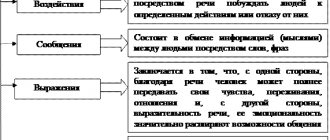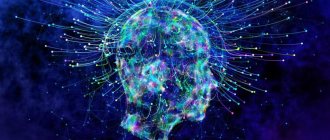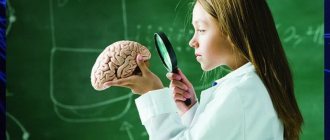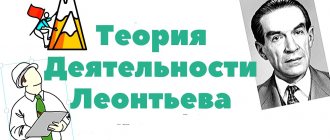Concept and essence
Primitive man sought to understand and transform the world around him.
At first he came into contact with nature, animals, and inanimate objects. As I developed, I learned to create, change objects, and transform nature. Activities are a controversial, little-studied topic. They began to pay active attention to it in the middle of the 20th century. A. Leontyev defined it as the process of satisfying the needs of the subject. For Soviet psychologists, it was not the activity itself that was important, but the mental processes based on it.
The term “activity” should be distinguished from the synonyms “movement” and “activity”. These terms describe the movement of matter. To describe the properties of inanimate matter, the term “motion” must be used.
The appearance of living matter caused the emergence of a new form of movement - activity. The actions that animals perform to maintain existence should be called life activities. The activity of an individual with awareness can be called full-fledged activity.
Some psychologists believe that highly organized animals also have the ability to engage in conscious activity. Primates, in addition to the actions necessary for survival, have the ability to play.
History of study and followers
A. Bernstein and P. Anokhin managed to identify general patterns. Psychologists studied the organization of movements, brain activity aimed at movement. This served as the basis for the creation of the theory of functional systems, which explains the structure of goal-directed activity.
According to the theory, goal-directed activity should consist of sequential elements. The motivation to initiate action is a perceived need.
For the first time, a description of the motif is found in the works of K. Obukhovsky, V. Kovalev. They conducted a series of experiments that showed that motive influences an individual's willingness to perform a purposeful action. Lack of motive is the reason for refusing to act.
Knowledge, abilities, skills, habits
Knowledge, abilities, skills, or KUN – the basis responsible for organizing and managing practical activities.
Knowledge
These are images of sensations and perceptions, later processed into ideas and concepts. Without them, conscious, purposeful activity is impossible. Knowledge increases the effectiveness of actions.
Skills
This is mastery of a method of performing an action that does not require reinforcement with exercises. Conscious individual control is the main difference between skills. They are closely related to thinking and are impossible without active intellectual activity. Skills allow you to find a way out of non-standard situations and respond to changes in external conditions.
Skills
Skills are actions brought to automaticity. The success of an activity depends on skills. Skills are formed through exercise - repeated repetition of a specific action (actions). The skill is based on a dynamic stereotype, that is, a neural connection between the elements of the action. This happens uncontrollably, but if any inaccuracy occurs, the person immediately notices it. The stronger the nerve connection, the faster and better the action.
Skills can be motor, thinking, sensory, behavioral. The skill is formed in several stages:
- introductory (comprehension of actions, familiarization with implementation techniques);
- preparatory (conscious but inept execution of an action);
- standardizing (unity and automaticity of actions);
- situational (mastery of arbitrariness of action).
Learning new skills is always influenced by old ones. Sometimes this helps, and sometimes it hinders. In the first case we are talking about coordination of skills, in the second – about interference (contradiction). Skills are aligned when:
- the movement system of one skill coincides with the movement system of another;
- one skill is a means of better mastering another;
- the end of one skill is the beginning of another and vice versa.
Accordingly, interference occurs under the opposite conditions.
Habits
A habit is an action that has become a need. Habits can be positive and negative. Habits, like skills, are based on dynamic stereotypes. Habits are formed through:
- imitation;
- multiple random repetitions;
- conscious, goal-directed learning.
They can be a driving force or a braking factor when performing an activity.
Structure and features
Scientists distinguish macrostructure and internal structure of activity. The macrostructure contains components responsible for simple and complex actions. The basic element of the structure is the operation. An operation is a set of movements aimed at accomplishing a given task. When motivation arises, a person draws up a program:
- forms a goal;
- selects an action;
- performs an action.
This totality is a macrostructure.
The internal framework discusses these components in detail. The need that arises in an individual is dictated by the discrepancy between the real situation and the desired result.
To set a record in sports, an athlete needs to train and develop skills. He cannot immediately fulfill the need. During training, he compares the result with the achievements of other athletes.
Based on this conclusion, psychologists came to the conclusion that the motive is the result of comparison and the desire to be like others.
Activity and the phenomenon of inaction
Activity is a form of mental existence. In animals, activity is determined by biological needs. It has already been mentioned that psychologists distinguish between purely human needs. Activity has a structure consisting of the following elements: motive, process of activity, purpose of activity, conditions of activity. Motives, as we have seen, generate interest and a desire to act. There is a need to solve a certain problem, indicating the goal and conditions for its achievement. The process of activity is determined by motive and consists of specific actions, each of which is associated with a goal. Primary activities may include work, learning and play.
Play . The game covers the entire human life. It permeates other basic phenomena of human existence. On this topic, the famous phenomenologist E. Fink writes: “Everyone knows what a game is, in addition to his own life, has an idea about the game, knows social games, knows the gaming behavior of neighbors, countless forms of games, circus performances, entertaining games and somewhat more intense ones. less easy and attractive than children's games, games of adults." Everyone knows these playful elements in the sphere of labor and politics, in the communication of the sexes with each other, playful elements in almost all spheres of culture.”
Fink considers play as a fundamental phenomenon of human existence and identifies its main features. For him, play is an impulsive, spontaneous and involuntary, energetic activity. The more often we intertwine with other life quests, the more aimless the game is, the more likely it is that we will find only absolute happiness in it. Fink believes that man, as a man, plays alone among all creatures. Play is a fundamental feature of our existence that no psychology can ignore.
We must, as Fink argues, one day collect and compare the gaming habits of all times and peoples, register and classify the vast heritage of objectified imagination embodied in human games. It will be a history of "inventions" other than the traditional artifacts (artificial facts) of culture, tools, machines and weapons.
The phenomenon of inaction. The foundations of human life, such as the will to power, the dictates of reason and the cult of violence, are today assessed by philosophical reflection. Today, a fundamentally different attitude has been clearly and comprehensively outlined and approved, embodying the unfulfilled possibilities of man, the varieties of his true existence.
Inaction is just as consistent with human nature as activity. Man, as an open being, is capable of realizing himself in various directions. The varieties of human existence that exist in world history in no way exhaust the resources and potential of man. A person is, in principle, capable of realizing other alternatives. Activity is the path to the realization of freedom only in one case, namely, when it is creative, that is, when it is creative.
Mental regulation of human behavior and activity is a complex process.
It covers a wide range of human motives and needs. People set different goals that determine their activities. The will and value orientations of people play a major role in human behavior. What is the final result of mental regulation? The goals of psychotherapeutic efforts are often cited as health, ability to work, the ability to realize one’s own potential and joy (Freud), adaptation to society (Adler), joy from creation and the experience of happiness.
Levels
Within the psychological structure of activity there are 3 levels that control certain types of actions: from lower to higher. Each individual has them and has varying degrees of internal control.
Unconscious level
At the unconscious level there are simple instincts inherent in humans and animals. They are regulated by biological mechanisms. Such instincts include actions aimed at satisfying vital needs: the instinct of reproduction, survival, self-preservation.
The mechanisms are not autonomous, they can be controlled. In a familiar situation, a person restrains internal aspirations; in a critical situation, control weakens and the mechanism is activated.
Subconscious level
The subconscious part is responsible for the work of skills and abilities that an individual acquires throughout life. It also contains the impulsive-emotional sphere: aspirations, moral attitudes, passions, drives. The subconscious level is the core of personality.
Conscious level
At the conscious level are knowledge and cultural norms. This part of the psyche controls others, controls instincts, not allowing the survival mechanism to start on its own. Control can be overcome.
In the human psyche there is a constant struggle between instinctive mechanisms and consciousness. Subjugation of the subconscious requires volitional effort. If consciousness cannot function normally, a person loses the ability to behave adequately. He is controlled by the subconscious and becomes dangerous to others.
Forms
A mentally healthy person should equally develop:
- Sensation is a reflection of the surrounding world using the senses. Helps to navigate the environment.
- Perception - recognizing an object, forming an image of an object.
- Representation is the recreation of an image of an object that does not affect the senses. Representation is impossible if memory and thinking are impaired.
- Thinking is a process necessary for collecting, storing information, and reproducing it. Participates in the operation of other processes.
- Attention is a response to a stimulus directed at an object. Directed attention is an active process of research and selection of information.
- Will is the level of expression of aspiration. Necessary to achieve the goal.
The development of individual forms occurs unevenly. The foundations and developmental trends are laid in childhood. If one form is not developed enough, it will negatively affect the others. Memory problems affect thinking, lack of will affects perception.
Individual style
Many psychologists emphasize that any personality theory has fairly general characteristics. Therefore, you always need to take into account the characteristics of a particular person.
Individual style includes temperament, experience, skills, knowledge. All this is developed at different levels in each individual. Therefore, achieving the same goal cannot be the same.
The person also chooses which techniques to use to implement the plan. They may be chosen incorrectly, then the individual analyzes his activities, finds mistakes and does not make them again.
Manifestations of temperament can also be considered an individual style. Despite the fact that the structure of the nervous system is the same for all people, the ratio of the processes of excitation and inhibition will be different. A phlegmatic person takes longer to work, but has less risk of making a mistake due to inattention. It is easier for a sanguine person to cope with several things. The human body is designed in a complex way. Many of its functions are formed only under the influence of the external environment.
Children do not think twice and imitate the behavior of adults, this influences the formation of style
At school age, a child learns self-control and reflection. An adult is influenced by the professional sphere; the development of an individual style of activity depends on it.
Classification
For normal existence, both types of activity are equally important: physical and intellectual. They are interconnected, subordinate to one mechanism aimed at harmonious development.
Physical form
Physical activity refers to movement performed to achieve a goal. The action occurs under the influence of motive and is associated with the work of physical functions. Physical activity is preceded by mental activity - first a person forms an image, then makes an attempt to embody it. Physical activity is necessary to meet the needs of life.
Intelligent Form
Intellectual activity can be realized without the participation of physical activity (thinking does not require physical movements). She participates in satisfying the lower and higher needs of life.
What it is
Activity is a form of human activity aimed at cognition, transformation of the surrounding world, oneself and the conditions of one’s existence. This is what distinguishes man from animals and emphasizes the social in human nature.
- Activities are not limited to meeting needs.
- It is determined by the goals and requirements of society.
- Actions are associated with the development of personality and human consciousness (including self-awareness).
- This is a consciously regulated process of human interaction with the world.
In activity, a person acts as a creator, creator. In its process, the following develop:
- intellectual abilities of the individual;
- creative imagination;
- worldview;
- system of ideals and values;
- emotional and aesthetic attitude to the world.
As a member of society, a person is valuable when he leads an active working and social life, commits actions and bears responsibility for them.
Subject of activity
Activity is always objectified. The subject is what it is aimed at. It can exist independently or be created in the process of the activity itself.
Operating principles
The activity is based on the principle of functionality and the principle of consistency.
- The first involves relying on already developed mental elements that are mobilized to achieve a goal.
- The principle of systematicity presupposes the inclusion of individual personality traits, on the basis of which several blocks in the structure can be identified.
Activity structure
Six blocks can be distinguished. Each of the elements is interconnected with others, interpenetrating.
Motives
This is where needs come into play. A motive is an objectified need. The desire to satisfy a need, that is, to obtain a specific item, encourages activity. Activity is impossible without motive.
Goals
Main element. It has two forms of manifestation:
- as a result represented by a person;
- as the desired level of achievement.
Program
A person decides what and how he should do, that is, it is a choice of methods and means, an assessment of his own resources. The work includes the cognitive, motivational, and executive spheres.
Information base
Its effectiveness depends on the adequacy and completeness of information about the conditions of activity.
Making decisions
One is selected from the alternative options, mastered, and rules and criteria for achieving the goal are developed.
Personal qualities that are significant for activities
These are character traits, abilities, inclinations and other individual characteristics that will help you achieve your goal.
Activity Components
Activity always has an internal plan and an external manifestation, between which there is an inextricable connection. From external operations with objects (objective thinking), information, transformed by the psyche, turns into internal images, ideals (imaginative thinking). The process of such a transition is called internalization.
The reverse action (creating something materially through internal representations) is exteriorization.
Action is a tool to achieve a goal
Action is a part of an activity aimed at achieving an intermediate result in specific conditions. Consists of operations - methods of execution according to conditions.
Physical actions
These are external, motor actions with objects that consist of movements.
Intelligent Actions
Internal mental actions with images and concepts based on external actions with objects.
Psyche – regulator of activity
The reflection of the world by the psyche occurs consciously, that is, in the process of actions a person:
- is aware (partially or fully) of the purpose of his actions;
- represents the result;
- perceives and evaluates the conditions in which one has to act;
- builds a step-by-step plan, an algorithm of operations;
- makes volitional efforts;
- observes the process;
- experiences successes and failures.
Functions
In order for actions to be directed and lead to the intended goal, a person must master 3 methods of developing mental processes:
- Play is a primary activity that helps a child develop mental processes. Through play, children undergo primary socialization and learn to interact with others. Play influences the development of thinking, preparing the child for the next method.
- Educational - necessary for the child’s formation in a team, choice, and mastery of a profession. The quality of education affects the child’s future life and choice of workplace.
- Labor - necessary for the implementation of professional skills and self-realization. Labor is important for the socialization of individuals, the process of evolution.
If a person has not mastered a story game in childhood, he will not be able to fully master the educational game and will lose the need to realize himself in work. It is difficult for such people to become a part of society; their social skills do not develop. Play is of key importance for preschoolers; for adults it can be used as a therapeutic method.
Afterword
Conscious purposeful activity is the difference between people and animals. In its process, a person creates objects of material and spiritual culture, transforms his abilities, ensures progress (although sometimes regression) of society, influences nature (preserves or destroys).
Any activity is a creative way beyond the natural, work on oneself and the world. Man not only consumes, but also creates. With her help he influences his life.
Thanks to it, the mental development of the individual is carried out. However, at the same time, mental processes (perception, attention, imagination, memory, thinking, speech) act as components and even separate types of activity.
Modern psychological science is based on such basic concepts as “personality”, “consciousness”, “activity”, “communication”. Often the concept of activity in psychology is interpreted as a unique form of the subject’s relationship to the world around him. Moreover, this attitude is conscious, aimed at its development and transformation to the extent that it seems appropriate to the individual. The role of consciousness depends on the type of activity - in scientific, work or play, its psychological component is different.
Activity is recognized as the basis for personality formation.
Articles on the topic
- The tasks of modern psychology in the field of development and formation of human personality
- Problems of modern psychology - science is plunging into crisis
- Methodological principles of psychology: current methods that allow you to study everything
- Corporate relations in modern society
A purposeful attitude towards the world is realized in the following types: cognitive, evaluative, spiritual or material, reproductive, creative and many others.
Study methods
The phenomenon was studied by domestic and foreign psychologists. Commonly accepted theories:
- Theory of S. Rubinstein. Activity is subject to external conditions. It is indivisible with consciousness and has a complex structure. To adapt to external conditions, a person must regulate behavior. A person learns control. At the same time, the connection between actions and consciousness develops.
- Theory of A. Leontiev. The researcher believed that internal activity is the transition of an external mental process into an internal one. A person with hearing loss can reproduce a sound in their mind even though they cannot hear it. Activity is a complex of operations that arose during the development of consciousness.
- Theory of L. Vygotsky. He considered activity as a result of the work of higher mental functions. Among primitive people, higher mental functions formed relationships between people, but were transformed into mental phenomena.
Since activity is a complex process, its study is possible only with the use of practical experiments and computer technology. This is a significant question for research in psychology, sociology, philosophy, biology and other sciences. Research results can change the idea of a person and their place in the world around them.
Psychology of activity
1.1 Category of activity in psychology: general and specific psychological content
A prominent methodologist of Russian psychology, B.F. Lomov, stated that the category “activity” has great explanatory power and is therefore very widely used in science and practice /84-86/. Analyzing the current state of the problem of activity in psychology, he noted that the term “activity” often has different contents, sometimes it is “glued” to various mental phenomena or is simply manipulated: “... based on the ambiguity of this term, it is used as the basis of concepts, in which the content of the concept “activity”, defined for one circle of phenomena, is transferred (sometimes without any changes, sometimes slightly transforming it) to another, qualitatively different circle of phenomena” /86, p. 192/. B.F. Lomov pointed out that “...the use of the category “activity”... without understanding its essence cannot give anything other than confusion and scholasticism” / ibid., 191/.
In its origin, activity is a socio-historical category and is studied primarily by the social, natural and technical sciences, that is, sciences bordering on psychology. Psychology uses the doctrine of activity as a socio-historical category to analyze and explain mental phenomena and therefore inevitably very often “... the psychological aspects of the analysis of activity are replaced by philosophical, sociological economic ones, etc., and vice versa” / 86, p. 193/.
Theoretical guidelines in the analysis of activity categories
The following can be identified as the most important generally accepted theoretical guidelines that reveal the meaning and general content of the category of activity.
1). The category of activity is the most important category characterizing human existence. Without this category, analysis of human existence is impossible /79,86,112/.
Activity characterizes human existence.
2). Activity refers to a specific form of activity (characteristic of a person and society) that transforms reality. Emphasizing the ambiguity of the word “activity”, B. F. Lomov, we note that in the broadest sense it refers to any active systems. In this meaning, it is equivalent to the term “activity” and, of course, can be used in the description and analysis of a very wide class of phenomena, including mental ones” /86, p. 192/.
In the broad sense of the word, the term “activity” is equivalent to the term “activity” (“activity” - activity, “action” - action).
Analyzing the basic mental processes, A. N. Leontyev points out: “The first thing that should be highlighted among the diverse forms of human activity is the various types of complex activities that carry out, respectively, different forms of a person’s relationship to reality (practical activity, cognitive activity, aesthetic activity etc.) /72, p. 18/.
Activity is the form and manifestation of activity.
3). The category of activity, while not being an exclusively psychological category, is traditionally considered generally accepted in psychology. It is one of the basic psychological categories along with such categories as mental reflection, personality, consciousness, communication (Fig. No. 1).
Rice. No. 1. Basic categories of psychology.
A. N. Leontiev identifies the following categories as “...the most important for building an integral system of psychology as a specific science about the generation, functioning and structure of the mental reflection of reality that mediates the life of individuals”: “This is the category of objective activity, the category of human consciousness and the category personality. The first of them is not only the initial one, but also the most important” /79, p. 12/.
B.F. Lomov considers the categories of reflection, activity, personality and communication as the basic categories of psychological science (“... in the sense that its conceptual apparatus is built on their basis” /86, p. 289/).
Activity is a basic category of psychology.
4). The category of activity is closely interconnected with the basic categories of psychology and interacts with them.
According to the views of A. N. Leontyev, mental reflection cannot be understood outside the integral system of activity. In a number of his studies, he showed that mental reflection is born in the process of development of sensory-practical activity, that the image (mental reflection) always occupies an essential place in the system of activity and that in isolation from activity it is impossible to understand either its genesis or its functioning /72– 73,75,78–80/.
The categories of activity and mental reflection are interconnected.
In the studies of B. F. Lomov, the relationship between the category of activity and the category of communication is traced, and the main functions of communication in activity are highlighted. He showed that communication performs several functions in activity:
1 - communication constitutes a transitional form of activity on the path of its transformation from collective to individual;
2 - communication is included in collective activity;
3 - communication itself is the most important type of human activity /84.86/.
The categories of activity and communication are interconnected.
The relationship between categories of activity and personality is revealed in a number of studies.
In the studies of A. V. Petrovsky, a person is considered as a subject of a stable system of social relations, realized in activity and communication; He considers the main characteristic of a personality to be its representation in the life activities of other people /99/.
B.F. Lomov, considering the basic categories for psychological science, emphasized: “...mental phenomena are formed, develop and manifest themselves in the processes of activity and communication. But they do not belong to activity or communication, but to their subject - the social individual-personality. Neither activity nor communication in themselves possess any mental qualities, and they do not exist in themselves. But the personality has this quality. Thus, both the problem of activity and the problem of communication are “closed” to the problem of personality... through the analysis of activity and communication (more broadly of all human life), psychology reveals... the mental make-up of the individual, his inner spiritual world”/86, p. 289/
The categories of activity and personality are interconnected.
Analyzing the genesis of consciousness, A. N. Leontyev shows its psychological multidimensionality through the interrelation of the categories of activity and consciousness. He is about /79, p. 124–125/. And further: “...It is obvious that the explanation of the nature of consciousness lies in the same features of human activity that create its necessity: in its objective, objective, productive nature” /79, p. 127/.
The categories of activity and consciousness are interconnected.
5). The category of activity performs two methodological functions in psychology:
1 - activity as an explanatory principle,
2 - activity as a subject of study (Fig. No. 2).
Rice. No. 2. Methodological functions of the category of activity in psychological theories.
A number of studies have shown that in the scientific works of L. S. Vygotsky the methodologist, the category of activity occupies a central place, and that the named functions of activity were first identified by him when formulating normative requirements for the construction and analysis of psychological theories /28,109–110/.
According to L. S. Vygotsky /22-25/, any psychological theory should contain the following central points:
1. The presence of a general explanatory principle (it explains the boundaries and structure of the theory).
2. The presence of the actual subject of study (the main concept). At the same time, L. S. Vygotsky clearly distinguished the categories of “explanatory principle” and “subject of research.”
3. The units of psychological analysis included in the conceptual apparatus of the theory are identified. The dimension of the unit of psychological analysis sets the explanatory principle; the unit of analysis can be used as an indicator of a theory's hidden explanatory principle.
The relationship between the categories “explanatory principle” and “subject of study” is dynamic.
Having identified two methodological functions of activity, L. S. Vygotsky actually outlined the contours of the activity approach in psychology.
The activity category performs two methodological functions.
6). In the explanatory dictionary of the Russian language by S.I. Ozhegov (1975), activity is defined as occupation, work.
Activity=work.
7). The specific psychological content of activity appears most clearly in the following working definitions.
In the modern psychological dictionary, activity is considered as an active interaction with the surrounding reality, during which a living being acts as a subject purposefully influencing the object and satisfying it. your needs /108*, from 95/.
A. N. Leontyev: “We do not call every process activity. With this term we designate only those processes that, realizing one or another relationship of a person to the world, meet a special need that corresponds to them” /80, p. 518/. Elsewhere we find: “Activity is a molar, non-additive unit of life of a corporeal, material subject. In a narrower sense, that is, at the psychological level, it is a unit of life mediated by mental reflection, the real function of which is that it orients the subject in the objective world. In other words, activity is not a reaction or a set of reactions, but a system that has a structure, its own internal transitions and transformations, its own development” /79, p. 81–82/. (The statements emphasize the main function of the activity - a landmark in the objective world and note its systemic structure).
S. L. Rubinstein: “...human activity as a whole is, first of all, an impact, a change in reality;... it is not only an impact, a change in the world and the generation of certain objects, but also a social act or relationship in the specific sense of the word. Therefore, activity is not an external doing, but a position in relation to people, society, which a person affirms with his whole being, manifested and formed in activity” / 112, vol. 2, p. 89/. (The statement represents the behavioral aspect).
V. D. Shadrikov: “...activity is a form of active attitude to reality, aimed at achieving consciously set goals related to the creation of socially significant values (“consumer values”) and the development of social experience / 131, p. 43/. (In this definition, activity is considered as a form of socially significant activity).










